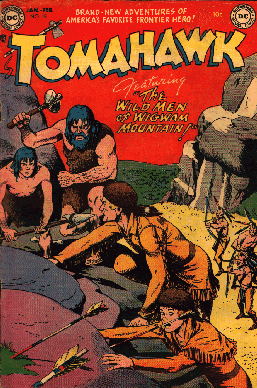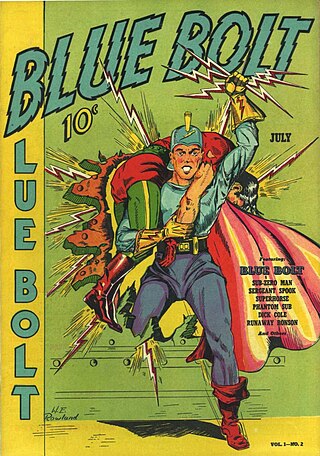
Miss Victory is an American superheroine who first appeared in Captain Fearless #1, published by Frank Z. Temerson's Helnit Publishing Co. Ceasing to be published after 1946, she was revived and updated in 1984 as a central character in the Femforce comic-book series published by A.C. Comics.

Sheena, Queen of the Jungle, is a fictional American comic book jungle girl heroine, originally published primarily by Fiction House during the Golden Age of Comic Books. She was the first female comic book character with her own title, with her 1941 premiere issue preceding Wonder Woman #1. Sheena inspired a wealth of similar comic book jungle queens. She was predated in literature by Rima, the Jungle Girl, introduced in the 1904 William Henry Hudson novel Green Mansions.
Black Fury is the name of several fictional comic book characters published in the Golden Age of Comics.

Miss America is a superhero appearing in American comic books published by Marvel Comics. Created by writer Otto Binder and artist Al Gabriele, the character first appeared in Marvel Mystery Comics #49 in the Golden Age of Comic Books. Madeline Joyce is the first incarnation of Miss America. The character has also been a member of the Invaders, Liberty Legion, and All-Winners Squad at various points in her history.

Black Widow is a character appearing in American comic books published by Marvel Comics. Created by writer George Kapitan and artist Harry Sahle, the character first appeared in Mystic Comics #4, published by Marvel predecessor Timely Comics. Claire Voyant is an anti-hero who kills evildoers to deliver their souls to her master, Satan.

Cat-Man and Kitten are a pair of fictional superhero characters created by artists Irwin Hasen (Cat-Man) and Charles M. Quinlan (Kitten) with unknown writers. Cat-Man was first published in 1940 by various Frank Z. Temerson companies. Due to circumstances during World War II, an altered version of Cat-Man was published in Australia and reprinted in the 1950s. AC Comics later revived the characters in the 1980s.

The All-Winners Squad is a fictional superhero team appearing in American comic books published by Marvel Comics. The company's first such team, it first appeared in All Winners Comics #19, published by Marvel predecessor Timely Comics during the period fans and historians call the Golden Age of Comic Books.

Jess Nevins is an American author and research librarian best known for annotated guides and encyclopedias covering Victoriana, comic books, genre fiction and pulp fiction. Among Nevin's books are Encyclopedia of Fantastic Victoriana,Horror Fiction in the 20th Century and Encyclopedia of Golden Age Superheroes. He has been a recipient and finalist for a number of honors, including the World Fantasy, Sidewise, and Locus Awards.

Tomahawk is an American comic book character whose adventures were published by DC Comics during the 1940s, 1950s and 1960s as a backup feature in Star Spangled Comics and World's Finest Comics and in his own eponymous series. He was created by writer Joe Samachson and artist Edmond Good, and first appeared in Star-Spangled Comics #69. Tomahawk's uniqueness stems in part from the time frame of his adventures: the American Revolutionary War.

The Blonde Phantom is a fictional masked crime fighter appearing in American comic books published by Marvel Comics. Created for Marvel predecessor Timely Comics by Stan Lee and Syd Shores, the character first appeared in All Select Comics #11, during the 1940s period fans and historians call the Golden Age of Comic Books. The heroine was so well received that the next issue was retitled The Blonde Phantom. The series continued to feature her until issue #22. She also appeared in backup stories in many other Timely comics; in Superhero Comics of the Golden Age, Mike Benton observes that "for a few months in 1948, readers could find her in seven titles on the newsstand." In The Supergirls, Mike Madrid asserted, "Once again, a capable woman hid behind a meek persona and only let her hair down, literally, to come to the aid of a man who completely ignored her unless she assumed a disguise. In a 1947 story entitled "I Hate Myself", Louise even dreams that Mark finally confesses his love for her, only to have the Blonde Phantom persona appear and steal him away."

Planet Comics was a science fiction comic book title published by Fiction House from January 1940 to Winter 1953. It was the first comic book dedicated wholly to science fiction. Like most of Fiction House's early comics titles, Planet Comics was a spinoff of a pulp magazine, in this case Planet Stories. Like the magazine before it, Planet Comics features space operatic tales of muscular, heroic space adventurers who are quick with their "ray pistols" and always running into gorgeous women who need rescuing from bug-eyed space aliens or fiendish interstellar bad guys.

Rulah, Jungle Goddess is a fictional character, a jungle girl, in comic books published by Fox Feature Syndicate. She first appeared in Zoot Comics #7. Matt Baker designed her, before Jack Kamen and Graham Ingels helped develop her image.
The Ghost is a superhero that appeared in comic books published by Nedor Comics. His first appearance was in Thrilling Comics #3. The character is loosely based on the pulp hero created by G.T. Fleming-Roberts, who was variously known as the Ghost, the Ghost Detective, and the Green Ghost.

The Woman in Red is a fictional character that first appeared in the period known to comic book historians as the Golden Age of Comic Books. Created by writer Richard E. Hughes and artist George Mandel, she first appeared in Thrilling Comics #2, published by Nedor Comics. The character was later revived by writer Alan Moore for America's Best Comics. She would also be used by Dynamite Entertainment in Project Superpowers Chapter Two.

Judy of the Jungle is a fictional character from the Golden Age of Comics; she appeared in comic books published by Nedor Comics. She first appeared in print in Exciting Comics #55.

Princess Pantha is a jungle heroine that appeared in comic books published by Nedor Comics. The character was revived twice; first by AC Comics, and then by writer Alan Moore for his Tom Strong spin-off, Terra Obscura. She first appeared in Thrilling Comics #56.

Fantomah is an American comics character, best known as one of the earliest comic-book superheroines. Created by Fletcher Hanks, the character first appeared in Jungle Comics #2, published by Fiction House. Hanks is also known for creating the equally strange Stardust the Super Wizard.

Blue Bolt is a fictional American comic book superhero created by writer-artist Joe Simon in 1940, during the period fans and historians refer to as the Golden Age of Comic Books.
The Moth is the name of two American comic-book superhero characters. The first was created by artist Jim Mooney and an unknown writer for Fox Feature Syndicate in 1940, during the period fans and historians call the Golden Age of Comic Books. The second was created by writer-artist Steve Rude in 1998 for Dark Horse Comics.
Mystic Comics is the name of three comic book series published by the company that eventually became Marvel Comics. The first two series were superhero anthologies published by Marvel's 1930-1940s predecessor, Timely Comics, during what fans and historians call the Golden Age of comic books. The third, simply titled Mystic, was a horror fiction-suspense anthology from Marvel's 1950s forerunner, Atlas Comics.
















